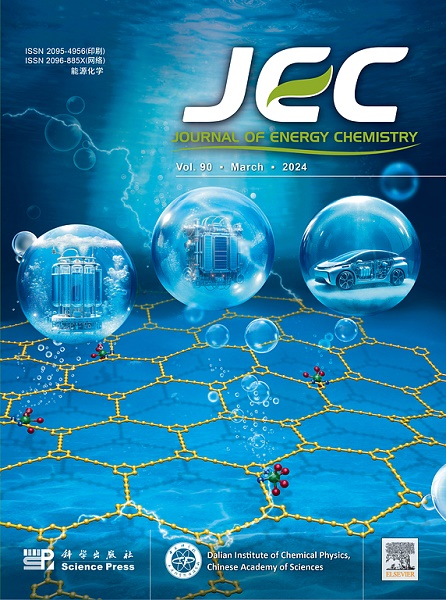Secondary growth of three-dimensional lead halide perovskite during the alkylammonium salts induced “in-situ healing” strategy
IF 13.1
1区 化学
Q1 Energy
引用次数: 0
Abstract
Two-dimensional (2D) precursor molecules-based surface treatment on three-dimensional (3D) lead halide perovskite (PVSK) has achieved huge successes, the in-depth understanding of the modification mechanism remains an urgent need. Here the effect of alkyl-chain length on the reaction dynamics between alkylammonium salts (XI) and 3D PVSK matrix is studied, through examination of surface morphological and crystallographic properties of the 3D PVSK matrix. It is observed that the average crystallite size of 3D PVSK increases as XI is either spin-coated on 3D PVSK or penetrated through carbon-electrode (during the “in-situ healing” process). Secondary growth is observed for 3D PVSK, which is related to ion-exchanging reactions. Prolonging alkyl-chain length favors the secondary growth. Besides, the formation dynamics of 2D PVSK are studied. Adding alkyl-chain length increases the yields. The observations are thoroughly discussed with respect to the steric-hindrance effect held by alky-chains of XI molecule. The improved crystallization of 3D PVSK and increased yields of 2D PVSK help accelerate charge extraction and reduce recombination across the interface between PVSK and carbon-electrode (CE). Tuning alkyl-chain length of XI molecules, and the mass ratio between XI molecules and carbon black could mitigate the “in-situ healing” effect. Power conversion efficiency (PCE) of the carbon-electrode-based hole-conductor-free planar perovskite solar cells has been upgraded from 14% to 17%, and further upgraded to 20.4% by utilizing relatively thick CEs. Thanks to the hydrophobicity of long alkyl-chains owned by XI molecules, prolonged stability has been achieved on unsealed devices at the high-moisture environment (RH ≈ 85%), meanwhile, shelf-stability up to 6400 h has been achieved. This study deepens the understanding of the 2D precursor-basing modification strategies.

求助全文
约1分钟内获得全文
求助全文
来源期刊

Journal of Energy Chemistry
CHEMISTRY, APPLIED-CHEMISTRY, PHYSICAL
CiteScore
19.10
自引率
8.40%
发文量
3631
审稿时长
15 days
期刊介绍:
The Journal of Energy Chemistry, the official publication of Science Press and the Dalian Institute of Chemical Physics, Chinese Academy of Sciences, serves as a platform for reporting creative research and innovative applications in energy chemistry. It mainly reports on creative researches and innovative applications of chemical conversions of fossil energy, carbon dioxide, electrochemical energy and hydrogen energy, as well as the conversions of biomass and solar energy related with chemical issues to promote academic exchanges in the field of energy chemistry and to accelerate the exploration, research and development of energy science and technologies.
This journal focuses on original research papers covering various topics within energy chemistry worldwide, including:
Optimized utilization of fossil energy
Hydrogen energy
Conversion and storage of electrochemical energy
Capture, storage, and chemical conversion of carbon dioxide
Materials and nanotechnologies for energy conversion and storage
Chemistry in biomass conversion
Chemistry in the utilization of solar energy
 求助内容:
求助内容: 应助结果提醒方式:
应助结果提醒方式:


